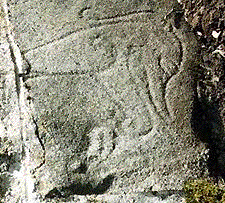|
| |
 |
Friends of
Grampian Stones
Clatt Dolphin |
 |
| The Class I incised design of a dolphin (in
19th century terminology of Victorian antiquarians, called a 'swimming elephant' or
'Pictish beast') was discovered in the foundations of the pre-Reformation chapel at Clatt,
near Rhynie in Aberdeenshire. Along with another broken stone, it lay in Clatt churchyard
for almost a century before being built into the churchyard dyke (wall) in 1890. The
second fragment of a double disc & Z-rod is now lost. A third carved stone, also from
Clatt kirkyard, now stands at the House of Knockespock nearby. Knock-espoch means
hill of the bishop - an indication of early ecclesiastic activity in a community
associated with the Pictish (and later Celtic) church. Bishops were consecrated as early
as AD700 in Pictland. |
 |
The little creature now stands on his head within the bottom course of building
material on the outer (car park) side of the churchyard. Compare this early realism of a
pre-Christian motif with the 9th century rendition of a rather stilted dolphin on the
'pagan' side of the Maiden stone.
On the Gartnach hill outside the village of Clatt, an earlier pre-Christian sacred well
was used until the Reformation as a place of blessing and called the 'Holy' or 'salmon'
well. The carved outline of a Pictish salmon along with an overhead arch [or horseshoe or
rainbow] was embedded next to the well until the early years of the 20th century. It was
moved to Percylieu (between Clatt & Druminnor) and trimmed for use as a door lintel to
the threshing mill. It was then rescued and has become a feature of the National Trust
property of Leith Hall near Kennethmont, where it stands in a garden shelter beside
another Pictish stone, the 'Tod' (wolf) stone from Newbiggin in Leslie parish near Insch.
Click for Pictish iconography ©1999MCNagahiro.
©1999-2000 Friends of Grampian Stones |
Return to
Friends of Grampian Stones Index Page
|

